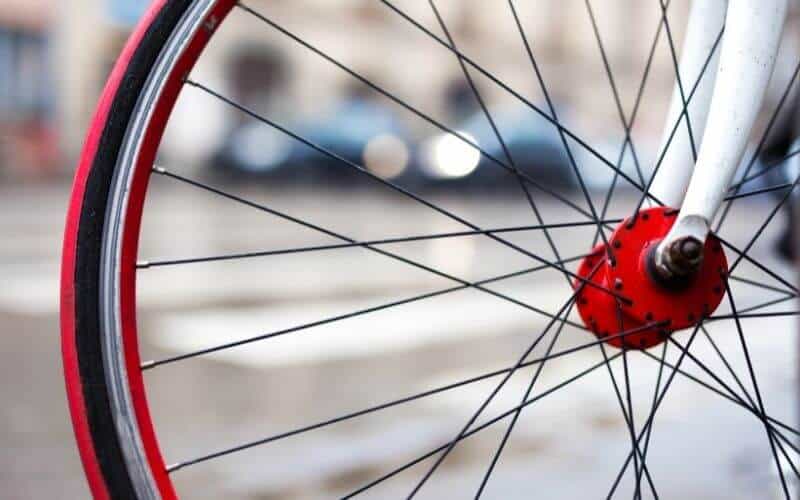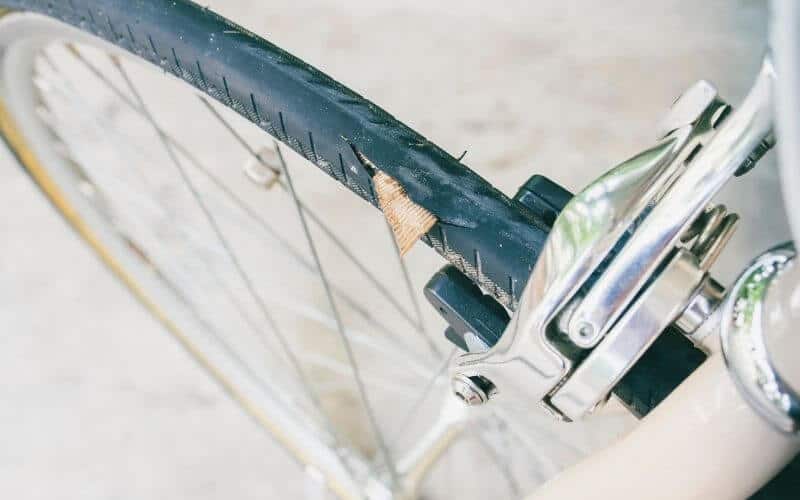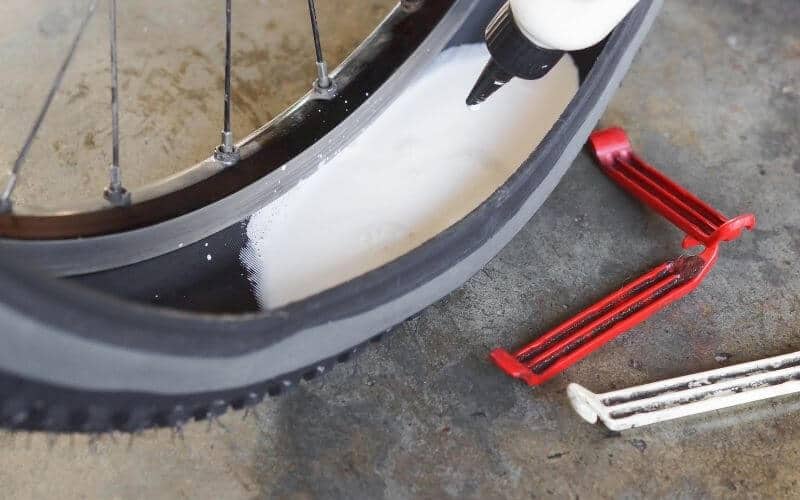Commuting on a bike can be a bit of a mission, right? What do you need to carry, and what can save you commuting time?
Anything that can save me commuting time, I want to know about, which is why I wanted to know whether switching to a tubeless setup for commuting would save me time and would overall be a better way of doing things.
If you are looking for an affordable way to improve your commuting experience, then tubeless is worth considering. The benefits outweigh the drawbacks if you do most of your cycling on smooth pavement. However, if you like to take off-road rides as well, then tubeless may not work out as well.
So, the ultimate question. Tubeless vs. inner tube for commuting – which is better? Tubeless has many advantages, as does running inner tubes, so let’s look at those advantages and throw in a few disadvantages too!
What Is An Inner Tube?
So the best way I can describe it is that an inner tube is like a balloon in a way. You can inflate and deflate it using a valve.
When you’re riding, the inner tube is your air cushion. It gives you a comfortable and safe ride.
More often than not, inner tubes will be made from either butyl rubber or latex. Latex gives you a bit more in the way of handling characteristics as it’s slightly more flexible. They also have the advantage that they are thinner and, therefore, lighter.
What Is A Tubeless Setup?
You are likely to be hearing this increasingly if you have your ear to the ground in the cycling world.
Tubeless means there is no inner tube in the tire. Between the tire and the rim, there is only air and sealant.
Appearance-wise, tubeless tires look like any standard tubed tire, but inside, you won’t find an inner tube. The tire gets ‘seated’ (this means the beads are snapped into position), and this forms the necessary airtight seal with the rim.
You will find that the valve is no different from what you find on an inner tube, but it’s connected directly to the rim.
In order for tubeless to work, everything needs to be totally airtight.
For a lot of high-end mountain bikes and gravel bikes, it’s the default option. It’s becoming increasingly popular on road bikes.

Can Any Bike Wheel Be Tubeless?
No. In order to run a tubeless set-up, you need to have specific tubeless wheels.
Tubeless wheels are designed to create an airtight space when you fit a tubeless tire into them.
This means that wheels that aren’t tubeless-ready are unable to keep the air pressure required inside.
These days, a lot of wheels are tubeless-ready and say so on the rim.
Pros Of Going Tubeless As A Commuter
Comfort
So when you use inner tubes, your tire pressure needs to be higher in order to avoid pinch flats.
This means that the comfort of the ride can sometimes be a bit uncomfortable, especially if your commute is over some very uneven road surfaces. I find this can be quite tiring on my body too.
The difference with tubeless is that your tire pressure is lower, so the ride is relatively more comfortable.
Time
When you’re on your way to work, and you get a flat, that can ruin your day, not to mention make you late for work.
With tubeless, the risk of getting a flat is dramatically reduced, so this should save you time and so prevent you from getting an earful from your boss!
If you ride on roads where you find you tend to get a lot of flats, then tubeless is really something worth considering for the time-saving alone.
Pinch Flats
Say bye-bye to pinch flats when using a tubeless setup!
So, pinch flats happen when the tire collapses, and the rim ends up bottoming out. The inner tube gets pinched as you find yourself usually with two little holes. This can happen easily when you hit hard objects, so maybe things like a deep pothole or a curb.
By going tubeless, you take away the risk, as there is no tube to pinch.

Cons Of Going Tubeless As A Commuter
Maintenance
I debated whether maintenance should be a pro or a con, but as what you need to do is different from having a tubed, I put it as a con, but it’s close!
As with any tire, you need to maintain the correct tire pressure. What you may find, which is what I’ve found, is that you have to do this more frequently. My tubeless tires seem to need a top-up much more regularly than my tubed tires.
You also need to ensure that you top up the liquid sealant fairly frequently, as it will block holes without you realizing it. Also, over time, it does solidify, so topping it up keeps it moving.
If you’re not planning on using your bike for a few weeks, ensure that you still give your tires the occasional spin to keep the sealant moving and prevent it from settling.
Speaking as someone who does this maintenance, I can tell you it’s fine and doesn’t take a lot of time or effort. However, there is more to do than if you’re using tires with inner tubes!
Messy
When the time comes to top up your sealant or change it, brace yourself, it’s going to be messy. Honestly, there’s no getting away from this. Just accept it (or take it to your local bike store!).

Can I Still Get A Flat Tire With A Tubeless Setup?
You can, though the thing with a tubeless tire is that they offer more puncture resistance when compared to tires with an inner tube.
With a tubeless tire, you can get a small puncture on the road and not be aware it’s even happened, as the sealant that flows through the tire will repair the hole as you’re riding.
That said, some holes are too big for the sealant to fix, and this is when a flat tire will occur. I will say that I’m two years into using a tubeless setup on one of my road bikes, and I’m yet to have a flat tire…famous last words!
Need to plug your tubeless tire when you’re out on the road?
How Long Does Tubeless Sealant Last?
Tubeless sounds magical; it seals itself with no more punctures; what’s not to love?
However, you do need to change your sealant, and different sealants have different lifespans.
Typically you can expect sealants that are latex-based to be good for around 9,000 miles. For those who opt for fiber-based sealant, you can look at the life of the tire. They also have the added benefit of being easier to maintain.
Sure, latex sealants are cheaper, and some riders find that they’re more effective, but they can dry out over time, and this is going to be more apparent the closer you get to 9,000 miles.
This is where the issue can start. As the sealant dries, it sticks to the rim and to the tire, so when you try to remove it, it’s difficult. In fact, if left too long, it can cause corrosion to your tire and rim.
With fiber-based sealants, things are a little different. They’re water-based, so the soluble properties remain for a long time.
How Often Should I Replace Tubeless Sealant?
Whilst sealant can last that long, I would recommend that you top-up or replace your sealant every 3 to 6 months.
Your tire is effectively repairing itself, so you have no way of knowing how much sealant it has used or lost.
You can also find that some sealants can start to clump up over time, especially around repair areas. This can cause the weight to distribute unevenly through the tire.
Want to top up your sealant? Here’s how!
Frequently Asked Questions
How Long Do Tubeless Tires Last?
Tubeless tires aren’t so different from regular tires. In theory, you shouldn’t have to change them until they’re worn down or unable to hold air.
What you could find is that you end up having to change the tire earlier if a puncture is so bad that it can’t be patched or the bead on the tire no longer seals with the rim correctly.
Are Tubeless Tires Faster?
Sadly not. It’s something that is hotly debated, but tubeless tires, when used on the road, tend to be a little slower, but the difference isn’t significant.
The sealant in the tires is what causes the slowness. When tubeless tires first came out, it was thought that they would be quicker, and the logic made sense. No inner tube, no additional friction, and therefore more energy.
It didn’t work out like that, as you need sealant, and that sealant moving around does make it slightly harder to pedal. So whilst tubeless tires have many advantages, speed is sadly not one of them.
Final Thoughts
There we have it. Are you about to rush out and change your commuter bike set up to tubeless?
For me, I like knowing that my risk of getting a puncture is minimal, or at least much reduced, and with tubeless, that’s what I get!
I don’t mind the bits of extra maintenance here and there – I like fiddling with my bike anyway, so it’s just another excuse!
What’s your commute like, and what’s your setup?

